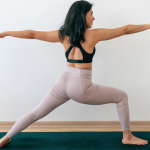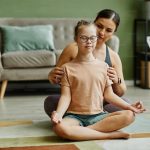If you’re a yoga teacher and a parent, you’ll know how difficult combining the two roles can be. You’ll be rushing out the door to a class only to realise that the kids have made a den out of your yoga blocks. Or you spend home practices with the TV blaring, a child sitting on your head, desperately trying to ignore the mountain of mess surrounding you.
However, if you look closely, yoga teaching and parenting have many similarities. In fact, becoming a yoga teacher could (and should) make you a better parent, while your experience as a parent can reap dividends once you’re establishing yourself as a yoga teacher.
Be An Example
As a yoga teacher students often look to you as an example, firstly of how the yoga pose they’re doing should look, but also, they will subconsciously copy your posture, stance and how you conduct yourself in between poses. You are providing them with their ideal mirror image.
In the same way, our children are looking to us as an example of how to talk, how to behave, how to be functioning human beings. When they’re little, they’re like sponges, sucking up everything that we do and say — especially when we’re caught off guard and do and say something we’d rather they didn’t repeat.
As they grow up, this copying becomes less obvious, but it’s still there. Anyone who’s become a parent will tell you of the moment that, horror-stricken, they come out with exactly the same expression as their parents.
If we remember the position we occupy as role models for our students and children, it serves as a timely reminder to watch our behaviour, and always try to set a good example. Not only in the way we do our yoga poses, but in the way we treat those around us, how we live our lives and how we interact with others.
See Also: Yamas and Niyamas: The Ten Attitudes to Help You Live a Fully Yogic Life
Encouraging and Cautious
Being a yoga teacher is a balance between cultivating willpower and persistence in your pupils and always having their safety at the heart of what you do.
There’s a reason that the Yoga Alliance requires 200 hours of training before yoga teachers can be certified – it’s a big responsibility. You are taking people outside of their physical comfort zones and asking them to trust you. You need to make sure you don’t abuse that trust by pushing your students too far or too fast. In the same way being a parent is a tricky balance of protecting your children — which is the fiercest and most overwhelming instinct that nature unleashes in you from the moment they’re born — and setting them free.
“If you love someone, set them free,” says the author Richard Bach, but of course, that’s easier said than done. My son is in his final year at primary school, and already, I can feel mounting pain and anxiety at the thought of him setting off on his own to get to school. But of course I have to let him go, or otherwise he’d never learn to be independent, never make his own mistakes and I would have failed in my role as a parent.
Mindful Attention
The key to yoga teaching is observation, observation, observation, says my yoga teacher trainer. It’s only by repeatedly looking at your students that you begin to really see the yoga poses in the student’s bodies.
However, it’s easy to being to teach from a habitual place, for example, by issuing an instruction that you’ve absorbed from your own teachers, without really looking at the students in front of you to see if they need it, or if it’s an instruction suitable for their level.
The key to maintaining mindful attention during classes is to be in the moment. Don’t go off topic when the students are holding a pose, everything has to be related to the pose they’re in.
In the same way, bringing mindful attention to your children is really important. It’s not possible all the time, we’re all human, and sometimes sitting them in front of the TV for a bit so you can gather your energy is absolutely fine, but it’s also easy to get distracted by the endless list of things we need to get done. The truth is, the list never gets ticked off, so sometimes you need to put the list to one side and read a book/play a game/or simply listen to your children, because their childhoods are over in a flash.
See Also: How Yoga Can Create Magic For Children
Putting Yourself First
When you become a yoga teacher you have to maintain a home practice, attend training days, go to your own classes and commit time and energy to your own practice. This discipline means that you have to carve out time for yourself, or you run the risk of letting your students down, not setting a good example and also of incurring injuries through not keeping your body supple.
Conversely, as a parent, carving time out for yourself, is one of the hardest things. During the safety spiel on a plane, they tell you to put your own oxygen mask on before your child’s. This is counter-intuitive for a parent. We get into the habit of putting our own needs last — or not even acknowledging our needs at all.
Yoga of Parenting tells us that, “the focus is on your relationship with yourself first, and from that grows an improved relationship with your child.”
If we can’t find the time to look after ourselves, we run the risk of not being able to look after our children. Yoga gives us the time and space to be with ourselves on the mat, and “re-charge our batteries” (Geeta Iyengar) in order to be better parents and teachers.













